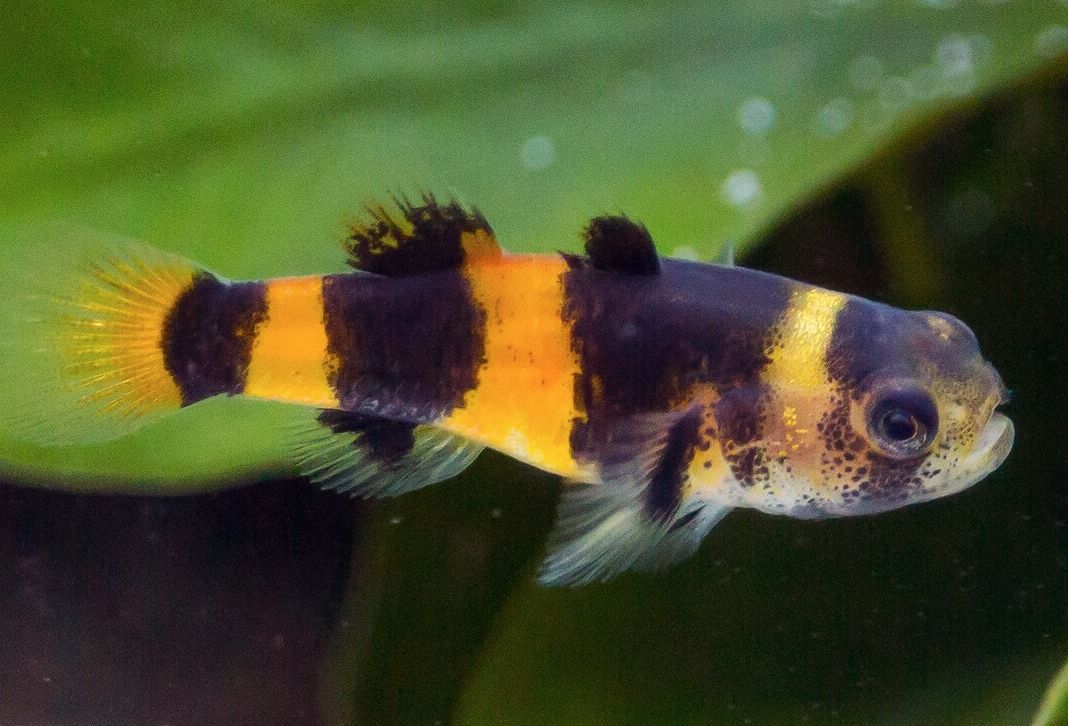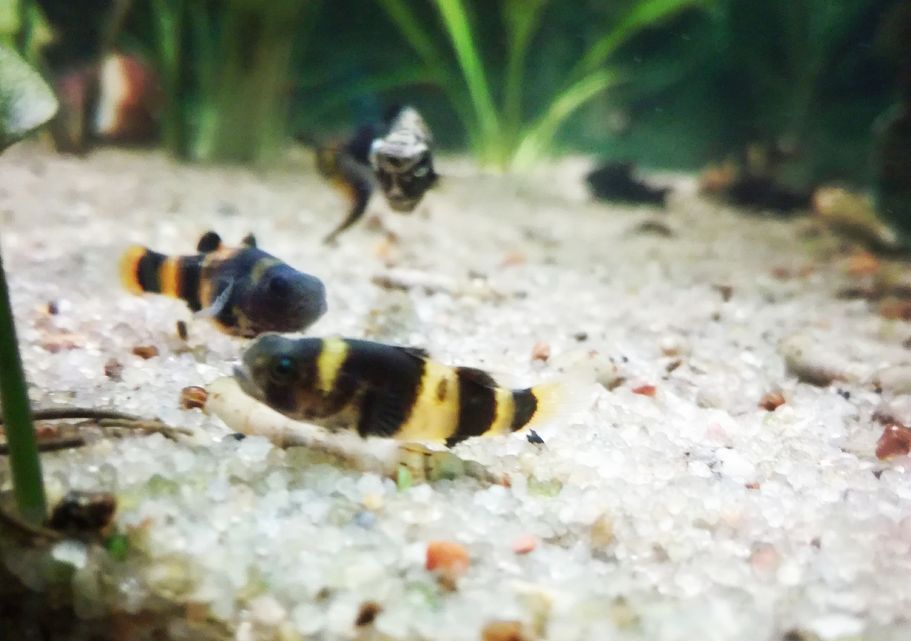The bumblebee goby (Brachygobius doriae) is a captivating, brightly colored fish that is highly sought after by nano tank enthusiasts. Known for its peaceful nature and striking appearance, it makes a delightful addition to small aquariums. In this article, you’ll discover everything you need to know about keeping bumblebee gobies, including their care requirements, feeding habits, suitable tank mates, and breeding tips.

Contents
Habitat in the wild
The bumblebee goby is classified under the family Gobiidae, which encompasses a variety of small, bottom-dwelling fish. Within this family, it belongs to the genus Brachygobius, known for its unique adaptations and vibrant appearance.
The bumblebee goby (Brachygobius doriae) hails from the brackish and freshwater environments of Southeast Asia, particularly in countries such as Thailand, Malaysia, and Indonesia. It inhabits lowland areas with brackish water along coastlines, including mangrove swamps and estuaries where rivers meet the sea.
In its natural habitat, the substrate typically consists of a mix of clay loam, sand, and mud, often enriched with organic materials like fallen leaves, tree roots, and driftwood. Some populations of bumblebee gobies are found in old peat bogs with black water, characterized by very low acidity, minimal electrical conductivity, and low hardness. Understanding these natural conditions helps in replicating a suitable environment for the goby in an aquarium.
| Characteristic | Description |
|---|---|
| Common Name | Bumblebee goby, bumblebee fish, bee fish |
| Scientific Name | Brachygobius doriae |
| Family | Oxudercidae |
| Size | Up to 4-5 centimeters (1.5-2 inches) in length |
| Body Shape | Cylindrical with a large head and compressed tail |
| Coloration | Primarily black with vibrant yellow or white stripes |
| Native Habitat | Southeast Asia (Thailand, Malaysia, Indonesia) |
| Habitat | Shallow, slow-moving waters, brackish and freshwater habitats |
| Behavior | Bottom-dwelling, territorial, perching locomotion |
| Tank Size | Minimum of 10 gallons for a small group |
| Water Parameters | Slightly brackish or freshwater, stable conditions |
| Substrate | Sandy substrate preferred for burrowing behavior |
| Diet | Carnivorous, feeds on small invertebrates and insect larvae |
| Compatibility | Peaceful, small fish or species-only setup |
| Breeding | Nest-builders, males guard and care for eggs |

Description
Body
The bumblebee goby has a distinctive body shape typical of its species, resembling an elongated drop that is flattened from the sides. Its head appears large in proportion to its body. Notably, its fused abdominal fins form a sucker-like disc that allows the fish to adhere to various surfaces, aiding in stability and movement. Additionally, the bumblebee goby features two dorsal fins, each equipped with both front and back soft rays. These anatomical adaptations contribute to its unique appearance and functional abilities in its natural habitat.
Color
When provided with optimal tank conditions, the bumblebee goby displays a striking and vibrant coloration. Its body features alternating golden-yellow and deep, dark stripes, creating a bold pattern that resembles a bee. This eye-catching appearance is the source of its common name. In addition to this pattern, some individuals may exhibit a blurry dark spot on their back, adding to the diversity of their appearance. This vivid coloration not only enhances the fish’s visual appeal but also underscores its distinctive identity in the aquarium.
Size
The bumblebee goby is a small fish species, typically reaching a maximum size of about 5 centimeters (2 inches) in the wild. In an aquarium setting, however, it usually grows to a slightly smaller size, averaging around 4.2 centimeters (1.7 inches) in length. Understanding these size variations is important for aquarium enthusiasts to ensure proper tank sizing and to accommodate the fish’s needs effectively.
Lifrspan
On average, bumblebee gobies have a lifespan of about 2 to 4 years in captivity. With exceptional care and optimal conditions, some individuals can live up to 5 years or slightly longer. Key factors influencing their longevity include maintaining high water quality, providing a balanced diet, ensuring an appropriately sized tank, and fostering good compatibility with tankmates. By focusing on these aspects, aquarium owners can help extend the lifespan of their bumblebee gobies and ensure their overall health and well-being.

Difficulties in keeping
The bumblebee goby is a small and vibrant fish with a distinctive appearance, but it comes with specific care requirements. This fish is relatively demanding due to its predatory nature; it will consume anything it can fit into its mouth. As a result, the bumblebee goby may not be the best choice for beginner aquarists. Its dietary needs and specific tank conditions require more experienced care to ensure its well-being and proper management in a home aquarium.
Keeping in a tank
Tank size
For a small group of bumblebee gobies, the recommended minimum tank size is approximately 38 liters (10 gallons). However, for optimal conditions, a tank size of at least 80 liters (20 gallons) is preferred. Bumblebee gobies are territorial and keeping them in a larger tank can help minimize conflicts and aggression. To ensure a harmonious environment, it is best to maintain a group of at least 6 individuals. This group size helps reduce aggression and allows the fish to exhibit more natural behaviors. Additionally, a tank with a large base area rather than depth is ideal, providing ample space for these active fish to explore and thrive.
Tank decor
Lots of shelters made of thickly planted tank plants is a must to make sure that weaker fish species don’t suffer from attacks of alpha male. Snags, artificial caves and flower pots will also do for this purpose.
Sand will be a good choice for the tank bottom substrate. You may add coral sand or marble gravels into the sand on the tank bottom to act as a buffer and put some sea salt into the tank water – about 2 grams per one liter of water. This isn’t obligatory, though it is useful in terms of disease prevention.
It’s not necessary to put plants into the tank, but if you want you can use some undemanding kinds, but before this they have to get acclimatized to living in brackish water.
Filtration
Successfully maintaining bumblebee gobies requires a focus on stable hydrochemical conditions and high water quality. To achieve this, a powerful filtration system is essential to ensure clean and well-oxygenated water. Regular maintenance is crucial and includes daily water changes and the removal of organic waste from the tank. Consistently monitoring and managing these factors helps create a healthy environment, supporting the overall well-being and longevity of your bumblebee gobies.
Water parameters
It’s important to remember that the bumblebee goby naturally inhabits brackish water environments, although some aquarists have successfully kept it in freshwater tanks. Despite this, brackish water remains the ideal condition for the fish’s health and well-being.
When selecting a filter for your tank, choose one that does not create excessive water flow, as strong currents can stress the bumblebee goby. For optimal tank conditions, maintain the following water parameters: a temperature range of 24–28°C (75–82°F) and a pH level between 7.0 and 8.5.
Diet
The bumblebee goby is a micropredator and primarily feeds on small live and frozen foods due to its carnivorous nature. Suitable food options include tubifex, bloodworms, brine shrimp, and daphnia, which are best gathered from the tank bottom where the goby naturally searches for food.
This fish is typically reluctant to eat artificial food and may not feed immediately after being introduced to a new tank. To encourage feeding, offer small portions of food frequently. Understanding and accommodating these feeding preferences are essential for the bumblebee goby’s health and adaptation to its new environment.

Tank mates
Keeping a small group of bumblebee gobies together can be a good option. They are social fish and usually tolerate their own species well. However, keep an eye on any signs of aggression or territorial behavior, especially among males. It’s generally recommended to keep gobies in a small group of at least 6 individuals. Keeping them in groups helps create a more natural social dynamic and reduces stress.
Bumblebee goby is not suitable for community tanks, since it requires brackish water and it is a territory dependent fish.
The males fight for their territory on the tank bottom and despite this it is recommend to keep not less than 6 species in a school to make sure that they don’t demonstrate aggression towards other tank dwellers. This is why there should be enough of shelters in the tank.
The bumblebee goby is compatible with other calm tempered species of equitable size and capable of living in brackish water. Fishes that swim in the middle water layers or near the surface are more preferable as tank mates.
Micropredators eagerly feed on shrimps, therefore it’s better not to keep them with cherry shrimp and other small shrimps.
Gender differences: male vs female
In bumblebee gobies, there are noticeable differences between males and females. Females tend to be larger and rounder, particularly before spawning when their abdomen becomes more pronounced. In contrast, males are generally slimmer and exhibit more vivid coloration. Their stripes are usually orange rather than yellow and intensify to a nearly red hue during spawning. These visual cues not only help in distinguishing between the sexes but also indicate the breeding process.

Breeding
The bumblebee goby can spawn both in a species and in a spawning tank. Bumblebee goby spawns in small caves which you can make from flower pots, empty tubes, shells.
It is better to get 6-10 species and give them a chance to form couples themselves in a natural way. Before spawning the fish should have high and diversified diet. Spawning is triggered with tank water renew, rising water temperature at several degrees and intensive aeration.
The spawning itself occurs in a shelter. The male chooses a proper place and waits till the female passes by. When the female is ready, she swims into the cave and lays 100-200 eggs and leaves them after that. The male fertilizes the eggs and stays to protect the offspring.
Females don’t take any part in growing the juveniles and you can remove them from the tank at this stage.
As for the males, they stay in the shelter and guard the eggs till the larvae hatches. Egg stage lasts for 7-9 days. The juveniles start to swim several days later.
First the juveniles feed on their yolk beg leftovers and then you should start feeding them with infusorians and rotifers. Even a short period of starvation may lead to mass mortality of the offspring.
When the juveniles grow a bit, they can eat chopped tubifex and brine shrimp nauplii.
The juveniles grow very slowly and they become 1 cm long only at the age of 1 month provided with high feeding. At the age of 2 month the bumblebee fish starts to demonstrate coloring and behavior peculiar to the adult species. The fish becomes reproductive at the age of 8-12 month.